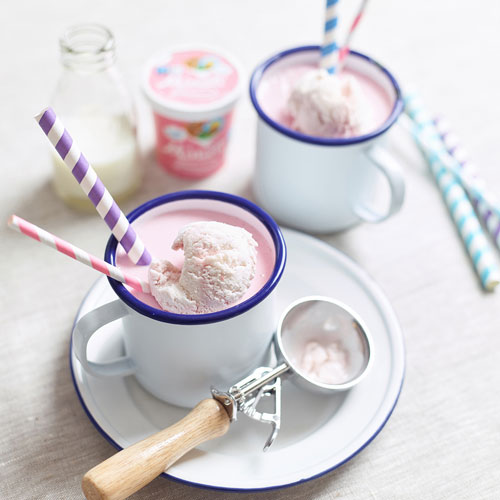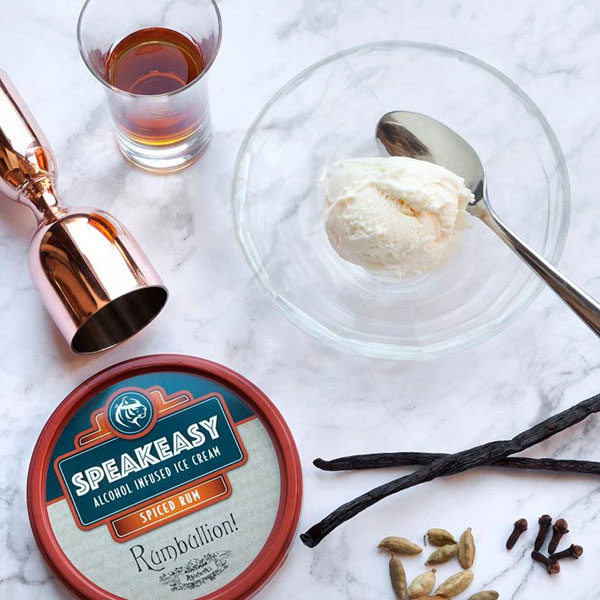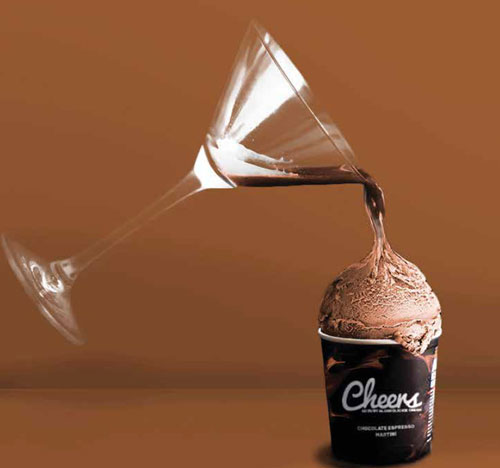Food trends: Ice-cream of the crop
Dessert menus have long evolved past vats of vanilla ice-cream offered as one scoop or two. Ian Boughton reports on the most innovative frozen options, from gelato to alcoholic sorbet
Ice-cream is not what it used to be. It is certainly no longer something to be dismissed at the end of a dessert menu with the words ‘one scoop/two scoops'.
Those who are backing this stance are agreed that ice-cream is no longer a second-rate dessert â" it is no surprise that a recent discussion has centred on how ice-cream can be seen as a sufficiently important part of a meal to win mentions from the top restaurant reviewers.
There are three strands to modern ice-cream: flavour, the move towards Italian gelato and the development of alcoholic ice-cream. Gelato is not simply a rebranding of ice-cream: it differs in fat content, creaminess, air content and even serving temperature.
âWe refer to our product as an ice-cream/gelato hybrid,â says Liena Wright. âBy fate we met our head of development, a third-generation Italian world champion in ice-cream, who has brought a skill and science to our ice-cream to create a hybrid which is made from fresh ingredients as true gelato should be, has exceptional ‘scoopability' and is very easy to work with, but also benefits from a 12-month shelf life, which gelato does not.
âWe feel this draws out the best aspects of Italian gelato making, but allows us to bring it into the chefâs kitchen is a sustainable way. So chefs who previously made their own ice-creams are now using ours instead as we deliver a premium product that they have not previously been able to get.â
A spoonful of sugar
Desserts arenât often considered for their health benefits, but according to the Minioti brand, it is possible to create a delicious ice-cream without added sugar. Founders Natasha Dowse and Anna Boletta explain: âLast year in the UK, 22% of all new ice-cream products were chocolate flavoured, with vanilla second at 18%. We are seeing lots of indulgent flavours coming in, but they come with a hefty calorie and sugar content.
Savour the flavour
Flavour is one of the big subjects in ice-cream, and now extends to the quite bizarre â" Northern Bloc reports seeing a charcoal flavour at a recent specialist show. How does the caterer decide which unexpected flavours to take a punt on without incurring too much risk?
âWe look to match flavours that complement each other rather than compete â" for example we've added fresh sorrel to our raspberry sorbet, which we feel gives it a further citrus hit and brings even more freshness to the raspberry."
âOur new vegan range made without refined sugar shows that if you need to choose a free-from diet, you donât have to compromise. The challenge was, how to make no-compromise, vegan ice cream thatâs free from additives? Weâve done it with strawberry and yuzu, chocolate and orange blossom, hazelnut and rose and peanut chip â" this is vegan, and itâs what ice-cream should be about.â
An unexpected flavour from Northern Bloc is black treacle, which won praise from a foodblogger chef who used it in a banoffee split with banana, pecans and rum, creating a more complex taste than using honey or caramel.
âBlack treacle works really well as an accompaniment â" it even works as an amazing float on top of a mocha porter⦠yes, a beer float!â says Wright. âWeâve also found that our grapefruit and bergamot sorbet makes an amazing addition to a cocktail, and raspberry and sorrel sorbet works well with a citrusy IPA beer.
Judeâs of Hampshire is also combining imaginative flavours with healthy options.They are launching their own vegan range into foodservice, using a coconut and soy base, and last year they did create a black ice-cream, having seen a trend for it in America â" this was their black coconut flavour.
Judeâs also created a new coffee flavour, based on the big drink of recent years, the flat white. In its liquid form, this drink relies on a particular dose of coffee, and specific treatment of the milk â" it took trial after trial to translate this into an ice-cream, says the brand.
Not just for kids
Judeâs is one of the brands which has seen the move towards alcoholic ice-creams. One experiment, which is not currently available, was the hot toddy ice-cream using Laphroaig malt whisky â" the idea being to create a winter pep-me-up ice-cream, a very unusual idea.
The Judeâs gin and tonic ice-cream won a prize in the last Great Taste Awards. âThis is made with Sipsmith craft gin, which is made in unique copper stills in small batches. It is a delicate botanical blend which is highlighted in our classic crème anglaise ice-cream and makes for a taste of summer in a scoop.â
This matter of alcoholic ice-cream is something which has to be understood to get the most from it, says the Speakeasy brand firmly. This is not a novelty, but a crafted project which gives chefs something genuinely new with which to work.
It is the partnership with drinks brands which avoids the ânoveltyâ aspect, she confirms. There are certain alcohols which do lend themselves to ice-cream use, and there are those which really do not; judging the right one is a matter of science, not just what seems a commercially good idea.
âThis is a very important point â" we produce a premium-quality ice-cream first and foremost, and so we ensure that the alcohol flavour profiles we select will really work in an ice-cream â" for example, our gin ice-cream is certainly not a gin and tonic, because in a creamy ice-cream this can just taste wrong. It can all be overpowered by the quinine in the tonic. We have also found that several berry-based liqueurs struggle to work as their flavour profile is dulled by the dairy, and the result remains just too subtle.â
And flavoured ice-cream bases do not work, she adds.
âOur specific model is to co-brand under licence with drinks companies to showcase the flavours of their alcohols, and we believe these flavours would be masked by adding them into a flavoured ice-cream. Ice-cream is a science, and it is essential to balance our formulation to the flavour ingredient, so we produce a bespoke neutral ice-cream base specifically for each alcohol.
âUnderstanding the science is even more important when you remember that alcohol is widely known as being an anti-freeze. It is well-known that an ice-cream with alcohol is problematic in a hot commercial kitchen for having melted by the time it reaches the table. This is usually a significant challenge, so we had to develop a product with foodservice in mind, which would have âmeltdownâ that would withstand a commercial kitchen, yet would be soft enough to scoop from the freezer. âMeltdownâ is a technical ice-cream term used to describe how well a scoop holds its shape before starting to melt.
âThe requirement is for specific adjustments to balance the flavours and alcohol by volume for each alcohol, to work in the ice-cream without compromising its quality and texture. Without working in partnership with the drinks companies, we would not have access to the information needed to achieve this.â
Typically, says Speakeasy, their chosen alcohols feature such items as Ableforthâs Rumbullion, which won the âbest spicedâ product sector at the World Rum Awards;Â they use the same brandâs cherry brandy, which is made with real cherries and French brandy, and the result is described as ârich and spicy with notes of dark cherries and almondâ.
How is such a premium product best promoted to the customer, in the sense of making them aware of it on a menu, and how is it best presented to the customer at the table?
âWe are a premium ice-cream, not a novelty frozen cocktail, and we find that once a chef tastes our product, their previous perceptions of alcohol ice-cream are shifted and they are inspired for lots of pairings and new desserts. So they may use us as a dessert garnish â" our cherry brandy with a chocolate brownie, or our gin ice-cream, which has refreshingly citrus tones, with a berry-based dessert, or our spiced rum with apple crumble.
âWe have certainly seen that when clients feature us in a dessert the amount of ice cream they buy from us significantly increases â" we can attest to the difference this makes to offering just âa scoopâ on the menu.â
Alcohol ice-creams have begun to crop up in different places â" in the Ice Cream Allianceâs 2018 awards, we find the âopen flavourâ class featured an espresso martini ice-cream, a cherry brandy, a boozy mince pie, and a grapefruit, lime and gin one. The Yummy Yorkshire brand from Denby Dale offers a âchocolate and boozy raisinâ flavour (and has also, to order, created such ice-creams as beetroot, garlic and basil!)
The regional Norfolk producer Alburgh sees an interest in unusual flavours, and the alcohol ones.
âWe do offer suggestions but often find that caterers are a lot more creative than we are,â says Alburghâs Lucie Morran. âWe did a sticky toffee ice-cream which some caterers called sticky toffee ice-cream, but others called âcaramelised date and treacleâ â" it was the same product, but caterers wanted a different name for different audiences. We find that our coffee ice-cream, which is one of our best-sellers, is used by some as a dessert in its own right, and by others as an accompaniment to a dessert â"Â it is often served with chocolate dishes."
Even independent companies have their own preferences for making their alcoholic ice-creams, and Alburgh has its own formula for a rum and raisin.
âYou do need to be careful with alcohol as it raises the freezing point of the ice-cream and can make it go too soft,â notes Lucie Morran. âSo you need to look at the alcohol content, and have a play from there. With our rum and raisin, we marinate the raisins in dark rum, and we add a very good rum flavouring to the ice-cream, before we put them together.â
The relatively new Cheers brand has put its entire effort into alcohol ice-creams. This, says the brandâs Lee Caulfield, is about giving the customer an experience they have never had before, which is the way to get a dessert mentioned in restaurant reviews.
âOur flavours include mojito (8.4% ABV), the strongest alcoholic ice-cream available in the UK, toffee and vodka (5%), strawberry daiquiri (7.9%) and a
chocolate espresso martini (3.5%). All this makes us different, and this is what gives the customer a whole new experience.â
The customer likes new ideas, argues Christina Veal, director at New Forest Ice Cream. An interesting confirmation of this is the performance of the brandâs mince pie ice-cream, which was introduced as a seasonal product and through demand is now available all year round.
âWhen we introduce new flavours, we look at what desserts and flavours are finding their way on to menus. We are not only looking at what flavours work as a solo purchase, but which will complement on-trend desserts. This is particularly important when we are discussing new flavours with chefs, as we are able to suggest options that will work in tandem with their latest creations.
âIce-cream offers the opportunity to add complementary flavours to a wide range of dishes â" our oriental ginger or salted caramel ice-cream can be a perfect accompaniment to a rhubarb crumble or sticky toffee pudding. The key is very often in how the flavours and varieties are described, either on the menu, or by the staff â" use your supplierâs resources to describe the flavours and ingredients, because these are a ready-made way to increase engagement with customers.â
Alcohol ice-creams do work, she says.
âThe trend for boozy ice-cream and sorbets has taken off because itâs a great balance between satisfying a sweet craving and having a refreshing beverage or cocktail. But it is important to feature the actual drink rather than just a flavouring, as those can leave the customer underwhelmed.
âThere are many drinks that work well. In our current range we have sorbets infused with gin and pink grapefruit, Champagne and Bucksâ Fizz, along with ice-cream featuring whisky and orange â" this has a dairy base infused with single malt whisky and citrus undertones from the orange zest. Itâs refreshingly light.
"Our gin and pink grapefruit is a great addition to dessert menus at the moment as gin has become a trendy drink choice â" it features Twisted Nose gin and is a balanced concoction of sweet and sharp notes.â
These are worth a little care in presentation, she says: âIf you are looking to include these on the menu, it is important that your presentation reflects the premium nature of the dessert. You can serve in the glassware that would normally hold the drink â" whisky tumblers or gin glasses will give a special touch.â
Flavour of the month
The way to get customers talking about your ice-cream is to make your own gelato, says Carpigiani, which has devised an infuser kit which makes it easier to add flavours. Sales director Scott Duncan says that chefs have already used it with unexpected results.
âWeâve had chefs creating a matcha green tea gelato and an Earl Grey gelato using loose leaf tea; and weâve seen a smoked salmon gelato as an accompaniment to a fish starter.
"Incorporating gelato or sorbet into multi-textured dishes is a great way to create a premium dessert menu at a much higher price point, and the profit from producing gelato in-house can be substantial compared to buying in ready-made ones.
And as with the ice-cream makers, Carpigiani recommends looking at the opportunities for alcohol ingredients: âThe use of alcohol needs to be handled with care, but beautiful, smooth alcohol-flavoured gelato can be achieved, and any cocktail can be transformed into a sorbet. The alcohol content needs to be carefully balanced, chefs now have the freedom to experiment with highly original creations that reflect the trend towards cocktail flavours, such as a pink gin gelato topped with a selection of glacé fruits, a subtle Prosecco sorbet⦠anything from Piña Colada to Negroni!â
Suppliers
Northern Bloc www.northern-bloc.com/professional 0113 320 6656
Speakeasy www.speakeasyicecreams.com 01622 831597
Judeâs www.judes.co.uk
Yummy Yorkshire www.yummyyorkshire.co.uk 01226 762551
Alburgh www.alburghicecream.co.uk 01986 788784
Ice Cream Alliance www.ice-cream.org 01332 203 333
New Forest Ice Cream www.newforesticecream.com 01590 647611
Cheers www.cheersicecream.co.uk 020 7836 6879
Minioti www.minioti.com 07700 335 848
Carpigiani www.carpigiani.co.uk 01432 346 018





















